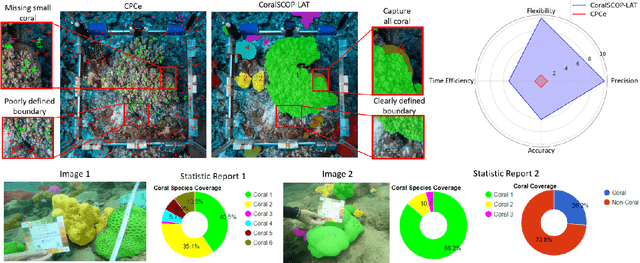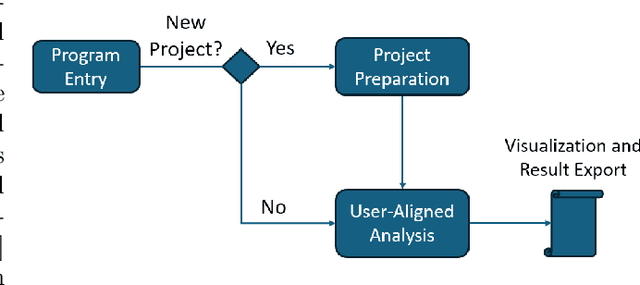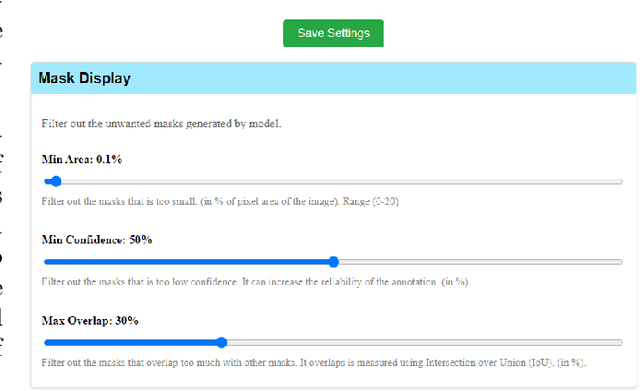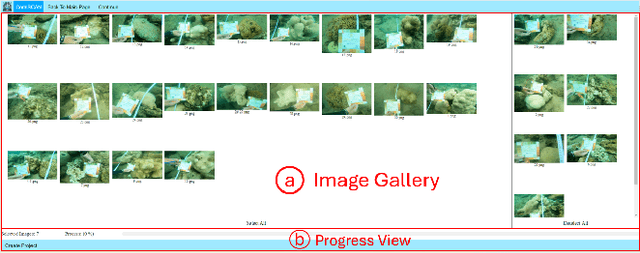Sai-Kit Yeung
MSC: A Marine Wildlife Video Dataset with Grounded Segmentation and Clip-Level Captioning
Aug 06, 2025Abstract:Marine videos present significant challenges for video understanding due to the dynamics of marine objects and the surrounding environment, camera motion, and the complexity of underwater scenes. Existing video captioning datasets, typically focused on generic or human-centric domains, often fail to generalize to the complexities of the marine environment and gain insights about marine life. To address these limitations, we propose a two-stage marine object-oriented video captioning pipeline. We introduce a comprehensive video understanding benchmark that leverages the triplets of video, text, and segmentation masks to facilitate visual grounding and captioning, leading to improved marine video understanding and analysis, and marine video generation. Additionally, we highlight the effectiveness of video splitting in order to detect salient object transitions in scene changes, which significantly enrich the semantics of captioning content. Our dataset and code have been released at https://msc.hkustvgd.com.
AUTV: Creating Underwater Video Datasets with Pixel-wise Annotations
Mar 17, 2025Abstract:Underwater video analysis, hampered by the dynamic marine environment and camera motion, remains a challenging task in computer vision. Existing training-free video generation techniques, learning motion dynamics on the frame-by-frame basis, often produce poor results with noticeable motion interruptions and misaligments. To address these issues, we propose AUTV, a framework for synthesizing marine video data with pixel-wise annotations. We demonstrate the effectiveness of this framework by constructing two video datasets, namely UTV, a real-world dataset comprising 2,000 video-text pairs, and SUTV, a synthetic video dataset including 10,000 videos with segmentation masks for marine objects. UTV provides diverse underwater videos with comprehensive annotations including appearance, texture, camera intrinsics, lighting, and animal behavior. SUTV can be used to improve underwater downstream tasks, which are demonstrated in video inpainting and video object segmentation.
Color Alignment in Diffusion
Mar 09, 2025Abstract:Diffusion models have shown great promise in synthesizing visually appealing images. However, it remains challenging to condition the synthesis at a fine-grained level, for instance, synthesizing image pixels following some generic color pattern. Existing image synthesis methods often produce contents that fall outside the desired pixel conditions. To address this, we introduce a novel color alignment algorithm that confines the generative process in diffusion models within a given color pattern. Specifically, we project diffusion terms, either imagery samples or latent representations, into a conditional color space to align with the input color distribution. This strategy simplifies the prediction in diffusion models within a color manifold while still allowing plausible structures in generated contents, thus enabling the generation of diverse contents that comply with the target color pattern. Experimental results demonstrate our state-of-the-art performance in conditioning and controlling of color pixels, while maintaining on-par generation quality and diversity in comparison with regular diffusion models.
SC-OmniGS: Self-Calibrating Omnidirectional Gaussian Splatting
Feb 07, 2025



Abstract:360-degree cameras streamline data collection for radiance field 3D reconstruction by capturing comprehensive scene data. However, traditional radiance field methods do not address the specific challenges inherent to 360-degree images. We present SC-OmniGS, a novel self-calibrating omnidirectional Gaussian splatting system for fast and accurate omnidirectional radiance field reconstruction using 360-degree images. Rather than converting 360-degree images to cube maps and performing perspective image calibration, we treat 360-degree images as a whole sphere and derive a mathematical framework that enables direct omnidirectional camera pose calibration accompanied by 3D Gaussians optimization. Furthermore, we introduce a differentiable omnidirectional camera model in order to rectify the distortion of real-world data for performance enhancement. Overall, the omnidirectional camera intrinsic model, extrinsic poses, and 3D Gaussians are jointly optimized by minimizing weighted spherical photometric loss. Extensive experiments have demonstrated that our proposed SC-OmniGS is able to recover a high-quality radiance field from noisy camera poses or even no pose prior in challenging scenarios characterized by wide baselines and non-object-centric configurations. The noticeable performance gain in the real-world dataset captured by consumer-grade omnidirectional cameras verifies the effectiveness of our general omnidirectional camera model in reducing the distortion of 360-degree images.
Align3R: Aligned Monocular Depth Estimation for Dynamic Videos
Dec 05, 2024



Abstract:Recent developments in monocular depth estimation methods enable high-quality depth estimation of single-view images but fail to estimate consistent video depth across different frames. Recent works address this problem by applying a video diffusion model to generate video depth conditioned on the input video, which is training-expensive and can only produce scale-invariant depth values without camera poses. In this paper, we propose a novel video-depth estimation method called Align3R to estimate temporal consistent depth maps for a dynamic video. Our key idea is to utilize the recent DUSt3R model to align estimated monocular depth maps of different timesteps. First, we fine-tune the DUSt3R model with additional estimated monocular depth as inputs for the dynamic scenes. Then, we apply optimization to reconstruct both depth maps and camera poses. Extensive experiments demonstrate that Align3R estimates consistent video depth and camera poses for a monocular video with superior performance than baseline methods.
CoralSCOP-LAT: Labeling and Analyzing Tool for Coral Reef Images with Dense Mask
Oct 27, 2024



Abstract:Images of coral reefs provide invaluable information, which is essentially critical for surveying and monitoring the coral reef ecosystems. Robust and precise identification of coral reef regions within surveying imagery is paramount for assessing coral coverage, spatial distribution, and other statistical analyses. However, existing coral reef analytical approaches mainly focus on sparse points sampled from the whole imagery, which are highly subject to the sampling density and cannot accurately express the coral ambulance. Meanwhile, the analysis is both time-consuming and labor-intensive, and it is also limited to coral biologists. In this work, we propose CoralSCOP-LAT, an automatic and semi-automatic coral reef labeling and analysis tool, specially designed to segment coral reef regions (dense pixel masks) in coral reef images, significantly promoting analysis proficiency and accuracy. CoralSCOP-LAT leverages the advanced coral reef foundation model to accurately delineate coral regions, supporting dense coral reef analysis and reducing the dependency on manual annotation. The proposed CoralSCOP-LAT surpasses the existing tools by a large margin from analysis efficiency, accuracy, and flexibility. We perform comprehensive evaluations from various perspectives and the comparison demonstrates that CoralSCOP-LAT not only accelerates the coral reef analysis but also improves accuracy in coral segmentation and analysis. Our CoralSCOP-LAT, as the first dense coral reef analysis tool in the market, facilitates repeated large-scale coral reef monitoring analysis, contributing to more informed conservation efforts and sustainable management of coral reef ecosystems. Our tool will be available at https://coralscop.hkustvgd.com/.
360VOTS: Visual Object Tracking and Segmentation in Omnidirectional Videos
Apr 22, 2024Abstract:Visual object tracking and segmentation in omnidirectional videos are challenging due to the wide field-of-view and large spherical distortion brought by 360{\deg} images. To alleviate these problems, we introduce a novel representation, extended bounding field-of-view (eBFoV), for target localization and use it as the foundation of a general 360 tracking framework which is applicable for both omnidirectional visual object tracking and segmentation tasks. Building upon our previous work on omnidirectional visual object tracking (360VOT), we propose a comprehensive dataset and benchmark that incorporates a new component called omnidirectional video object segmentation (360VOS). The 360VOS dataset includes 290 sequences accompanied by dense pixel-wise masks and covers a broader range of target categories. To support both the development and evaluation of algorithms in this domain, we divide the dataset into a training subset with 170 sequences and a testing subset with 120 sequences. Furthermore, we tailor evaluation metrics for both omnidirectional tracking and segmentation to ensure rigorous assessment. Through extensive experiments, we benchmark state-of-the-art approaches and demonstrate the effectiveness of our proposed 360 tracking framework and training dataset. Homepage: https://360vots.hkustvgd.com/
StyleCity: Large-Scale 3D Urban Scenes Stylization with Vision-and-Text Reference via Progressive Optimization
Apr 16, 2024



Abstract:Creating large-scale virtual urban scenes with variant styles is inherently challenging. To facilitate prototypes of virtual production and bypass the need for complex materials and lighting setups, we introduce the first vision-and-text-driven texture stylization system for large-scale urban scenes, StyleCity. Taking an image and text as references, StyleCity stylizes a 3D textured mesh of a large-scale urban scene in a semantics-aware fashion and generates a harmonic omnidirectional sky background. To achieve that, we propose to stylize a neural texture field by transferring 2D vision-and-text priors to 3D globally and locally. During 3D stylization, we progressively scale the planned training views of the input 3D scene at different levels in order to preserve high-quality scene content. We then optimize the scene style globally by adapting the scale of the style image with the scale of the training views. Moreover, we enhance local semantics consistency by the semantics-aware style loss which is crucial for photo-realistic stylization. Besides texture stylization, we further adopt a generative diffusion model to synthesize a style-consistent omnidirectional sky image, which offers a more immersive atmosphere and assists the semantic stylization process. The stylized neural texture field can be baked into an arbitrary-resolution texture, enabling seamless integration into conventional rendering pipelines and significantly easing the virtual production prototyping process. Extensive experiments demonstrate our stylized scenes' superiority in qualitative and quantitative performance and user preferences.
Improving Referring Image Segmentation using Vision-Aware Text Features
Apr 12, 2024Abstract:Referring image segmentation is a challenging task that involves generating pixel-wise segmentation masks based on natural language descriptions. Existing methods have relied mostly on visual features to generate the segmentation masks while treating text features as supporting components. This over-reliance on visual features can lead to suboptimal results, especially in complex scenarios where text prompts are ambiguous or context-dependent. To overcome these challenges, we present a novel framework VATEX to improve referring image segmentation by enhancing object and context understanding with Vision-Aware Text Feature. Our method involves using CLIP to derive a CLIP Prior that integrates an object-centric visual heatmap with text description, which can be used as the initial query in DETR-based architecture for the segmentation task. Furthermore, by observing that there are multiple ways to describe an instance in an image, we enforce feature similarity between text variations referring to the same visual input by two components: a novel Contextual Multimodal Decoder that turns text embeddings into vision-aware text features, and a Meaning Consistency Constraint to ensure further the coherent and consistent interpretation of language expressions with the context understanding obtained from the image. Our method achieves a significant performance improvement on three benchmark datasets RefCOCO, RefCOCO+ and G-Ref. Code is available at: https://nero1342.github.io/VATEX\_RIS.
OmniGS: Omnidirectional Gaussian Splatting for Fast Radiance Field Reconstruction using Omnidirectional Images
Apr 08, 2024Abstract:Photorealistic reconstruction relying on 3D Gaussian Splatting has shown promising potential in robotics. However, the current 3D Gaussian Splatting system only supports radiance field reconstruction using undistorted perspective images. In this paper, we present OmniGS, a novel omnidirectional Gaussian splatting system, to take advantage of omnidirectional images for fast radiance field reconstruction. Specifically, we conduct a theoretical analysis of spherical camera model derivatives in 3D Gaussian Splatting. According to the derivatives, we then implement a new GPU-accelerated omnidirectional rasterizer that directly splats 3D Gaussians onto the equirectangular screen space for omnidirectional image rendering. As a result, we realize differentiable optimization of the radiance field without the requirement of cube-map rectification or tangent-plane approximation. Extensive experiments conducted in egocentric and roaming scenarios demonstrate that our method achieves state-of-the-art reconstruction quality and high rendering speed using omnidirectional images. To benefit the research community, the code will be made publicly available once the paper is published.
 Add to Chrome
Add to Chrome Add to Firefox
Add to Firefox Add to Edge
Add to Edge